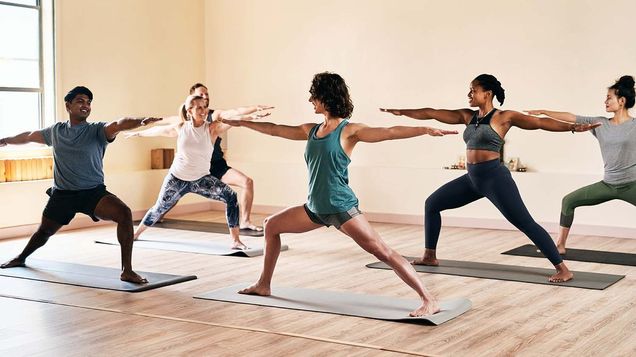Yoga – A Therapeutic Approach for Addressing Trauma
Written by Bessel van der Kolk in 2014, The Body Keeps the Score: The Brain, Mind, and Body in the Healing of Trauma is a New York Times bestseller that looks at trauma and its impact on reshaping the brain, mind, and body.
Part five of this novel, titled “Paths to Recovery”, introduces the audience to a number of therapeutic ways in which individuals address trauma in hopes of healing from their traumatic experiences. This may include “finding a way to become calm and focus, learning to maintain that calm in response to images, thoughts, sounds, or physical sensations that remind you of the past, finding a way to be fully alive in the present and engaged with the people around you, and not having to keep secrets from yourself, including secrets about the ways that you have managed to survive” (van der Kolk, 2014). One in particular stood out which will be the focus on this blog post and that is yoga.
In The Body Keeps the Score: The Brain, Mind, and Body in the Healing of Trauma, van der Kolk highlighted the impact that mediation has on the brain, specifically yoga. When an individual alleviates the muscle tension in their body, this allows the individual to relax and feel a sense of calmness. Individuals who are experiencing trauma may feel tense or numb because of the trauma that they endured or still continue to endure (van der Kolk, 2014). However, yoga allows these individuals to feel connected to their bodies again. Additionally, yoga therapy is designed to regulate an individual’s arousal and control their physiology (van der Kolk, 2014). Van der Kolk found in a study that ten weeks of yoga reduced PTSD symptoms in individuals who previously attempted to use medications to reduce PTSD but failed (van der Kolk, 2014). In order to relax the mind and heal from trauma, mediation is key.
A 2022 study done by the Cleveland clinic looked at 64 women who were living with chronic, treatment-resistant PTSD (“How Yoga Can Help Heal Trauma”, 2022). The researchers decided to split the women in two groups for them to participate in: trauma-informed yoga or women’s health education. 52% of women no longer met the criteria for PTSD after participating in the yoga trial while only 21% of women no longer met the criteria for PTSD after participating in the education trial (“How Yoga Can Help Heal Trauma”, 2022). Trauma informed yoga is designed to make you feel safe and relaxed. By participating in this, individuals are more likely to feel in control of their body and mind rather than a stranger in their own body and mind (“How Yoga Can Help Heal Trauma”, 2022).
Yoga also plays a major role in prisons. Most incarcerated individuals face feelings of anxiety, stress, and trauma as they are locked in cells for a long period of time. Written by Dragana Derlic, A Systematic Review of Literature: Alternative Offender Rehabilitation—Prison Yoga, Mindfulness, and Meditation is an article that focuses on the importance of yoga, mindfulness, and mediation in order to reduce recidivism and increase the likelihood of rehabilitation (Derlic, 2020). The initiation of yoga programs in prisons is designed to reduce negative thoughts, create a sense of relaxation, strengthen inmates’ attitudes, and show them that there are people out there that still care about them and their health. Not only does yoga reduce stress, anxiety, and trauma, but yoga also plays a vital part in improving an individual’s physical and mental health (Derlic, 2020).


References
Derlic, D. (2020). A systematic review of literature: Alternative offender rehabilitation—prison yoga, mindfulness, and meditation. Journal of Correctional Health Care, 26(4), 361–375. https://doi.org/10.1177/1078345820953837
“How Yoga Can Help Heal Trauma” (2022). Cleveland Clinic. Retrieved from https://health.clevelandclinic.org/trauma-informed-yoga
van der Kolk, B. (2014). The body keeps the score: Brain, mind, and body in the healing of trauma. New York. Penguin Books.
3 comments
Dylan, I love the idea of yoga in the prison system! Studies have shown that it reduces stress and aggression for those who participate. Yoga was beneficial in both women’s and men’s facilities and offered classes on a weekly or biweekly basis. Simply giving incarcerated individuals an outlet and something to look forward to is worth the minimal financial investment required for yoga.
This was a very interesting topic. In my approach to personal care discussion posts I wrote about the benefits of spending time in nature. After reading your blog post it seems that there is an overlap between these two ideas and their benefits. The van der Kolk study you mentioned in regards to PTSD and the effect yoga has on it is fascinating. I am all for ways that an individual can improve their mental health, and yoga seems to be a free and easy alternative with other added benefits as well.
Great post, Dylan! Throughout the course, I enjoyed reading about the different approaches to treating trauma, including the alternative approaches, such as yoga, mindfulness, and service animals. In regards to trauma-informed yoga, I think it is really important that it approaches stress safety, predictability, structure, and repetition, and that the poses are modified in an attempt to focus on breathing and embodiment.
Comments are closed.